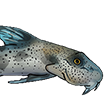L#'s
- MatsP
- Posts: 21038
- Joined: 06 Oct 2004, 13:58
- My articles: 4
- My images: 28
- My cats species list: 117 (i:33, k:0)
- My aquaria list: 12 (i:10)
- My BLogs: 4 (i:0, p:164)
- Spotted: 187
- Location 1: North of Cambridge
- Location 2: England.
-
mcman
- Posts: 9
- Joined: 18 Dec 2007, 20:48
- Location 1: paris ontario
- Interests: motorcycles,fishing,and fish
so is that the same for bristlenoseMatsP wrote:Since was described in 1988, around the same time as L-numbers were introduced, this fish never got one. L-numbers are [or should at least] only be used for fish that haven't yet got a scientific description.
--
Mats
[Mod edit: fix "disable bbcode" -- Mats]
fish,fish,and more fish
- MatsP
- Posts: 21038
- Joined: 06 Oct 2004, 13:58
- My articles: 4
- My images: 28
- My cats species list: 117 (i:33, k:0)
- My aquaria list: 12 (i:10)
- My BLogs: 4 (i:0, p:164)
- Spotted: 187
- Location 1: North of Cambridge
- Location 2: England.
Ok, so there's two other species of the genus that have an L-number, L155 and . These species, presumably, have been given L-numbers because it wasn't clear to DATZ [the German magazine that issues L-numbers] that the fish in question is actually a described species - it can be quite difficult to identify a fish down to species - some of the descriptions are written in other languages than English [e.g. Spanish, German or French], and range from "excellent" or "pretty darn poor" in their "descriptiveness". If the fish is then also caught outside the "known distribution", it's probably safer to say "this is NOT the same as the previously known species", until proven otherwise, rather than the other way around.
Well, it probably depends on "what bristlenose pleco" you mean. There are roughly 100 different species (77 of which are in the Cat-eLog, but there are around 30 that are scientifically described, but not in the Cat-eLog], some are scientifically described, some have L-numbers, and some "have both" [and many of those were described long before 1988 too].
If you are talking of the "common tankbred Bristlenose", , then it's a different problem: This fish used to be available wild-caught under several scientific names, but the tank-bred species has not been for sale as wild-cuahgt in several years. It is likely that the species came from a country that no longer does export of wild-caught fish, e.g. Venezuela. This in turn means that it's very hard to trace it's origins, because there is no one that can say "Yes, we caught this fish in River X", which cuts down on the number of brown fish with lighter spots that we can choose from to give this fish a name. Another possibility, which has been suggested, would be to do DNA analyzis of a few candidates [Someone in the fish-science actually offered to do the work, but no one has yet been able to offer some suitable "known species DNA" to compare with - it's very easy to get tank-bred DNA, but to make a match, we need something we know what it is!]
--
Mats
Well, it probably depends on "what bristlenose pleco" you mean. There are roughly 100 different species (77 of which are in the Cat-eLog, but there are around 30 that are scientifically described, but not in the Cat-eLog], some are scientifically described, some have L-numbers, and some "have both" [and many of those were described long before 1988 too].
If you are talking of the "common tankbred Bristlenose", , then it's a different problem: This fish used to be available wild-caught under several scientific names, but the tank-bred species has not been for sale as wild-cuahgt in several years. It is likely that the species came from a country that no longer does export of wild-caught fish, e.g. Venezuela. This in turn means that it's very hard to trace it's origins, because there is no one that can say "Yes, we caught this fish in River X", which cuts down on the number of brown fish with lighter spots that we can choose from to give this fish a name. Another possibility, which has been suggested, would be to do DNA analyzis of a few candidates [Someone in the fish-science actually offered to do the work, but no one has yet been able to offer some suitable "known species DNA" to compare with - it's very easy to get tank-bred DNA, but to make a match, we need something we know what it is!]
--
Mats








/g/s/1.jpg)
/g/s/1.jpg)